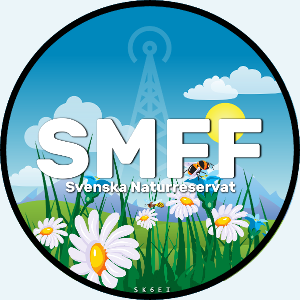SMFF - Svenska Naturreservat
Help
Here we have gathered important information and explanations pages
Map
All nature reserves on the map are marked with different colors. The mark is positioned at the center of the area. You can sit anywhere within the area.
The map is centered over locator specified under "Mina uppgifter" in the log. Current GPS position of the cursor is available at the at the top left. Right-click displays the nearest 400 areas of the current position. Left click on the area mark displays the ID, name, and position. Double-clicking zooms in and recenters the map.
Search by "Id" lists who have activated the area and when. You can also show all your worked areas by typing mina egna in "Områdesnamn".
The current map can be exported to a GPX file for eg Display other maps. Note that the character encoding is UTF-8!
GPS is activated by clicking the GPS-icon in the upper left of the map. Note that the GPS in the computer or mobile device have to be activated to get the exact location. Also note that it will take a while before the GPS report the exact location. The function generates a trace of GPS-points. If there are too many, you may reload the map and re-enable the feature.
 | General spot |
 | Activated area - RSTS completed (worked on CW is marked with a dot) |
 | Worked area - RSTM completed |
 | Activated and worked - Both RSTM & RSTS completed (worked on CW is marked with a dot) |
 | GPS track |
External maps
Länsstyrelsen webbgis
Natura 2000 network viewer
Naturvårdsverket
Last active (Senast aktiva)
Displays last day's activity in the log in terms of activated areas.
Five colors indicate timeliness.
GREEN - Area exists in log.
RED - QSO less than 5 minutes.
BLUE - QSO from 5 - 15 minutes.
BLACK - QSO older than 15 minutes.
GREY - QSO older than ca. 12 hours.
Click on area-ID to show the location on the map.
It is important that home operator logs directly and to online time for the information to be useful to others! Synchronize clock against a time server. If the time error is too large the Last active will not be updated.
Chime selectable on / off, with or without repetition under "My data" in the "Logbook".
Last active automatically updated and ping when a new area added to the list.
RBN-information
Two options are available. Either via the menu or in Latest spots ("Senast aktiva") where a spot is marked with ">>>>". The same colors as abowe applies with the exception that the spot is removed after 30 minutes. To be spotted you must be registred and that the CQ is transmitted on 3544 +/- 3kHz.
Spotsdelivered by SK3W via The Nordic Skimmer www.voacap.com/skimmer in Finland.
Latest spott is automatically updated and there will be a chime if a new area is added.
Spotting
You may spot yourself if CQing without any response. This is done in the log book by entering the following: QSOCall "SPOT", OmrS "Your area", Anteckning "QRG". That is, SPOT, Area number and Frequency by four digits.
Rules
- No unnecessary spotting.
- Station have to stay on the spotted QRG at least 5 minutes.
Diploma
Diploma management is automatic and is marked with a link in the log book next to the current score.
After the diploma has been created, it can be downloaded and printed via the Diploma.
Previous years diplomas can be generated in logbook history. Note this is noly valid for one year backwards in time.
The blog
 Posting in blog should be related to the activity Swedish Flora Fauna.
Posting in blog should be related to the activity Swedish Flora Fauna.
Think about what you write. Posts that may be considered objectionable or offensive may be deleted, the same applies to images. Note that all posts without images automatically will be deleted after 7 days.
Own posts can always be edited. Have a post received comments it can no longer be removed. To delete a post you must first delete all images.
Think of the image rotation. There is a feature Auto rotation of images that reads the image's EXIF data and rotates the image right.
The blog is updated automatically every 10 minutes.
Results
Here are all the results broken down by total points, activated and worked areas. Paying competitors are displayed with blue text. In addition, you will find all the rival teams and your personal statistics.
To see rival teams' statistics, click the signal below run worked (Körda onråden).
You can also easily email a person by clicking the signal in the points listing (Poängtävlingen) if you're logged in.
History is available for the previous years. To get the total history over the years, select year "0".
Log book
When logging, data to the other station are crosschecked. To get a confirmed QSO time must be within +/- 45 min, area-ID must match.
Cross Checking is also done against the received field. In this way, one can easily see if an area has already been run. If so it will be highlighted green. Note, the control of the broadcast area will not occur.
Event Viewer can be sorted by unconfirmed QSOs by checking the box at the bottom of the log. It is also possible to search any call in any logbook. Last years QSO:s will be archived 31/12. No data will be changed in the archive!
It is possible to upload and export an ADIF file using the following standard. When exporting the entire log is always exported. The log file can be edited with ADIF2XLS.
Offline Logging:
Logging can be done with SMFFSKLog43 Please note, we provide no support whatsoever to the program which you can download here.
SMFFSKLog Ver-4.3
